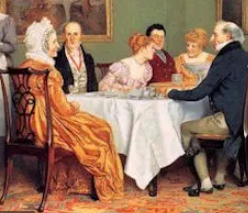In Sense and Sensibility, Elinor and Marianne Dashwood receive their first unflattering glimpse of a finnicky Robert Ferrars in Gray’s Jewelers as he takes his time choosing a toothpick case:
He was giving orders for a toothpick-case for himself, and till its size, shape, and ornaments were determined, all of which, after examining and debating for a quarter of an hour over every toothpick-case in the shop, were finally arranged by his own inventive fancy, he had no leisure to bestow any other attention on the two ladies, than what was comprised in three or four very broad stares. – Jane Austen
Good dental hygiene is not a modern concept. Toothpicks have been found alongside their owners in ancient Egyptian tombs, and the Chinese freshened their breath as early as 1600 B. C. by chewing on aromatic tree twigs. The world’s first known recipe for toothpaste, a mixture of rock salt, mint, dried iris flower, and pepper, came from Egypt. The development of toothpastes in more modern times started in the 18th century. A bicarbonate of soda or baking soda, the main raising agent in baking powder, was traditionally used for cleaning teeth and included in tooth-powder . A 19th century London Times advertisement promised an assortment of wonderful results for those who used tooth powder:
For the TEETH. Patronized and used by his Royal Highness the Duke of Kent. TROTTER’s ORIENTAL DENTIFRICE, or ASIATIC TOOTH POWDER, had been for 20 years acknowledged by the most respectable Medical authorities, used by many, and recommended. The Powder cleanses and beautifies the teeth, sweetens the breath, posses no acid that can erode the enamel, and puts a beautiful polish on the teeth. From its astringency, it strengthens the gums, eradicates the scurvy (which often proves the destruction of a whole set of teeth), preserves sound teeth from decay, secures decayed teeth from becoming worse, fastens those which are loose, and proves the happy means of preventing their being drawn. – Next Year, Last Century
A dentist named Peabody was the first to add soap to toothpowder in 1824. Betel nut, though to reduce cavities, was also mixed into certain recipes. By the 1850s chalk was included and in the 1860s a home-made toothpaste recipe incorporated ground charcoal. Recipes for tooth powder varied and were zealously guarded by their creators:
Toothpowders were based on three or four components: abrasives such as chalk, orris root, heavy magnesium carbonate or cuttlefish bone; antiseptics and detergents, represented by powdered hard soap and borax; and astringents which could be the tannins found in cinchona bark, bayberry leaves, essence of sassafras, and, very commonly, tincture of myrrh. Aromatic substances were often added as breath sweeteners, common ones being cardamon, cloves, peppermint, oil of lemon and aniseed. – Dental practice in Europe at the end of the 18th century By Christine Hillam, p. 214
The first toothbrush was made around 1780 by William Addis of Clerkenald. Addis also manufactured tooth brushes made of cattle bone. Boar bristles were placed into bored holes and kept in place by a thin wire. Interestingly, boar bristles remained in use until 1938, when nylon bristles began to replace the natural fiber.

Toothbrush holder made of bone, early 1800
Toothbrush bristles were the stiff, coarse hairs taken from the necks and shoulders of swine who lived (preferably) in the colder climates of Siberia and China. Tooth powder was packed in a variety of boxes, like the one in the image below.

19th c. toothpowder box
By the early 1800s, a variety of toothbrush and toothpowder manufacturers were competing with each other for a rapidly growing number of clientele in a thriving toothpowder trade. Tooth powder recipes proliferated, and toothbrushes began to be sold in great quantities. Sometimes both the tooth powder and toothbrush were sold together ( ‘Bott’s Tooth Powder and Brushes’, Newspapers (1798).
M. Trotter, a widow, manufactured tooth powder and tooth brushes in her warehouse on No. 36, Surrey-street in the Strand. Her tooth powder cost 2s 9d a box and her India Tooth Burshes cost 1s each. She was so successful that in a few years she moved into larger premises. Dental Practice in Europe, p. 212

18th c. silver flask-shaped comfit box

Anise comfits
Breath fresheners took the form of comfits made of anise, caraway, and fennel seeds. These sugary seeded confections were laborious to make, requiring dozens of thin sugar coatings. The seeds needed to be continually stirred in order to spread the coat evenly, and each sugared coat had to harden before the next coat was poured on. The process was repeated until the comfits had reached the proper size. When a comfit is chewed, the fennel or anise seeds are crushed open, freshening the breath for 15 minutes up to half an hour. People are still served this type of candied seed in Indian restaurants today.
More information on this topic:








Excellent post. I hadn’t realized tooth powders and brushes were already so prevalent in the Regency.
Thank you for posting this. :o)
Hi,
I’m following your blog since several weeks; Every day, I’m surprised by the richness of your posts, and how interesting they are! But today, I can’t resist no more to tell it to you, because your research about teeth care under Regency period is nothing but unbelievable!
I’m very found of Jane Austen, but I’m french, and in my country it’s not so easy to find informations about her; That’s why I’m really glad I found your blog. I would like to thank you for the pleasure you give me every day!
Have a nice day!
Thank you, Jamey and Malyss. I love sharing the information I learn about this fascinating period. Knowing that people find it useful is very gratifying! Vic
Fascinating stuff! Thanks for all the research you do.
I’ve always kind of wondered when teeth brushing became more and more common place. Interesting post. I find it kinda funny that they were becoming more concerned about the health of their teeth, but would chew of sugar coated seeds to freshen their breath! Guess the ADA (or British equivalent) hadn’t come about to tell them sugar can cause cavities! :D
The details are amazing on such a simple thing as an antique toothpick holder. Interesting timing since I just read that passage in S&S the other evening and returned from the dentist this morning. Thank you for the historical insight!
I am loving those toothpick holders…I had been a bit curious about these things ever since I watched Lost in Austen!
Brilliant post! Thank you so much for all your research! I am always excited to learn more about the everyday life back then, and this post was most informing! :D
I wonder what sort of training a dentist went through at that time. What is the social status of a dentist, as compared to a doctor?
Fascinating post, even though I absolutely hate to go to see a dentist!
Bargain with the Devil
Enid – You may find a few answers about dentists in Dental Antiques http://www.phisick.com/zdental.htm
[…] Dental Hygiene in the Regency Period […]
[…] Read Dental Hygiene in the Regency Era on this blog. […]
[…] More about the history of tooth hygiene: Jane Austen’s World […]